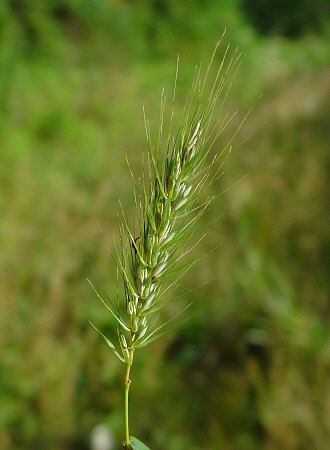Description: This native perennial grass is about
2½–4' tall with unbranched culms. These culms are terete, light
green, glabrous, and erect. Several alternate leaves occur along the entire
length of each culm. The blades of these leaves are up to 2/3" across and 12"
long; they are medium to dark green, hairless on both sides, and rather floppy.
The leaf sheaths are medium green, open, and usually hairless; less often, they
are sparsely
short-pubescent. The ligule of each leaf is papery. Each culm terminates in an
erect floral spike about 2-6" long; this inflorescence is densely covered with
ascending spikelets that are sessile, or nearly so. Often, the floral spike is
partially enclosed or barely exerted from the sheath of the uppermost leaf.
Each spikelet has a pair of glumes, a cluster of 2-4 lemmas, and their florets;
The glumes and lemmas are narrowly linear-lanceolate, about 1/3–1/2" long
(excluding the awns), and 1.0–2.5 mm. across at the base; their straight
awns are ½–1¼" long. In var. submuticus, these awns
are absent. The convex exterior of each glume or lemma has 4-5 longitudinal
veins. The anthers of the florets are white or cream-colored. The blooming
period occurs during the summer; the florets of the spikelets are
wind-pollinated. Each fertile lemma produces a single long grain. The root
system is fibrous. This grass forms small tufts of leafy culms through
vegetative offsets; in time, it can form a coarse sod.
sparsely
short-pubescent. The ligule of each leaf is papery. Each culm terminates in an
erect floral spike about 2-6" long; this inflorescence is densely covered with
ascending spikelets that are sessile, or nearly so. Often, the floral spike is
partially enclosed or barely exerted from the sheath of the uppermost leaf.
Each spikelet has a pair of glumes, a cluster of 2-4 lemmas, and their florets;
The glumes and lemmas are narrowly linear-lanceolate, about 1/3–1/2" long
(excluding the awns), and 1.0–2.5 mm. across at the base; their straight
awns are ½–1¼" long. In var. submuticus, these awns
are absent. The convex exterior of each glume or lemma has 4-5 longitudinal
veins. The anthers of the florets are white or cream-colored. The blooming
period occurs during the summer; the florets of the spikelets are
wind-pollinated. Each fertile lemma produces a single long grain. The root
system is fibrous. This grass forms small tufts of leafy culms through
vegetative offsets; in time, it can form a coarse sod.